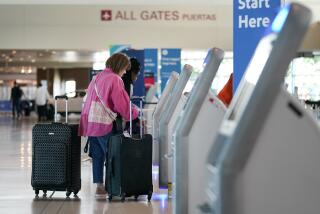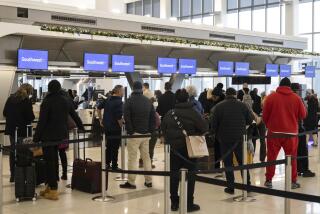Battered Airlines Seek Immediate Federal Aid
- Share via
WASHINGTON — Warning of economic disaster, airline executives made an urgent appeal to the Bush administration and Congress on Tuesday to quickly approve federal aid--perhaps about $17 billion--if their industry is to survive last week’s terrorist attacks.
Their plea came as workers at the nation’s two largest airlines--American and United--braced for job cuts involving tens of thousands of employees, which could come within three days.
Those two carriers and most others already have slashed their permanent operations by 20% or more and are preparing to cut a like number of jobs because of huge financial losses and dwindling cash reserves.
Details of the rescue plan, including how much financial aid the White House and Congress are willing to support, are being worked out. But Democratic and Republican lawmakers, who see the airline industry’s troubles as threatening a broad swath of the U.S. economy, hope to send an aid package to the president’s desk as early as next week.
Efforts to craft a broader economic stimulus package will advance today when President Bush meets with congressional leaders to discuss legislative options.
Although the airline industry began the day saying it needed as much as $24 billion--including $11.2 billion in loan guarantees and $5 billion in cash--its request for an additional $7.8 billion in tax relief ran into resistance from the White House and some members of Congress.
Rep. Roy Blunt (R-Mo.), the House chief deputy majority whip, who met with airline executives, said the aid was necessary to send a “strong message to the capital markets as well as the financial markets that the Congress and the administration are watching this sector with particular concern.”
As lawmakers met with the airline executives, an industry letter being circulated around Capitol Hill warned that “airline bankruptcies will commence within days, absent U.S. government financial support.”
Leo F. Mullin, Delta Air Lines’ chief executive and one of the airline chiefs at a White House meeting with Bush economic and budget advisors, said the administration gave an “excellent response” to all elements of the package.
“We are in very urgent need of a financial infusion very, very quickly, and we are very positive in terms of what we hear back from the administration. . . . ,” he said.
Hearings on Aid to Begin Today
Details of the aid package are expected to come more sharply into focus after congressional hearings, which begin today.
But Rep. James L. Oberstar of Minnesota, the top Democrat on the House Transportation Committee, said lawmakers were considering a $17.5-billion package--$5 billion in cash and $12.5 billion in loan guarantees. “The airlines have realized that they have to narrow the scope of their package,” he said.
The airlines also are expected to ask U.S. regulators to take over the expense of airport security. American and United also are pressing for a cap on their liability stemming from the use of their hijacked jetliners in the attacks. Both of those issues are expected to be taken up separately from the aid package.
Investors expressed cautious optimism about a federal rescue, as several airline stocks rebounded slightly from the sector’s sell-off Monday.
How did the airlines get in trouble so quickly?
The industry, which moves more than 665 million people annually and receives combined revenues of nearly $130 billion, generates a lot of cash but also has enormous fixed costs, or bills that must be paid daily. Those include payments on the airlines’ massive debts--which industrywide total about $30 billion--and labor costs.
The airlines operate with thin profit margins even when they’re healthy; last year, the carriers had combined profits of $2.6 billion, which is a meager two cents for every dollar of revenue.
And even the healthiest airline needs to fill roughly 65% of its seats on average to break even. But so far, many airlines are flying routes with only 40% or 50% of their seats filled.
When the revenues stopped for two days during last week’s shutdown, and then amounted to only a trickle as service slowly resumed, the airlines still had to keep paying those fixed costs. The result: They lost $200 million to $300 million a day.
They’re still losing money--analysts estimate the industry will have a record-breaking loss of about $7 billion for the full year--and most airlines’ cash reserves are expected to run out within a month.
That’s why the airlines are pleading with Washington for immediate help. Otherwise, they and industry experts say, one or more carriers would have to seek bankruptcy protection, perhaps within days.
Airline labor unions support a relief package but want it to include job protection as well as enhanced unemployment benefits and retraining for displaced workers, labor officials said.
But for now, labor leaders say, they’re scrambling to keep up with the job cuts. More than 28,000 jobs already have been slashed by US Airways, Continental Airlines and several regional carriers.
“We don’t have any hard numbers from any airlines yet,” said Joe Tiberi, spokesman for the International Assn. of Machinists, which represents 140,000 airline workers, from mechanics to flight attendants. IAM officials planned to meet today with executives from the major airlines to get details on the reductions.
Regardless of whether the airlines receive aid from Washington, their long-term viability will rest in large part with the U.S. consumer.
If much of the public remains skittish about flying for the next few months and doesn’t fill airplanes above the break-even point, the airlines will be hard-pressed to recover--bailout or not, analysts said.
That quandary could be exacerbated if the United States retaliates against the terrorists, renewing fears about the safety of flying.
House Minority Leader Richard A. Gephardt (D-Mo.), who also attended the Capitol meeting, urged travelers to begin flying again.
“This industry is part of the economic foundation of this country,” he said, adding that the airlines’ troubles threaten airplane manufacturers, hotels and other industries.
Congress has provided taxpayer-funded bailouts of private industry before--most notably $1.5 billion in federal loan guarantees to Chrysler Corp. (now part of DaimlerChrysler) in 1979 and a $250-million loan guarantee to the Lockheed Corp. in 1971.
Other Economic Remedies Studied
Congressional leaders, meanwhile, are beginning to focus on a broader plan for stimulating the economy. Before meeting with Bush today, House and Senate leaders will confer with Federal Reserve Chairman Alan Greenspan, Bush economic advisor Lawrence B. Lindsey and former Treasury Secretary Robert Rubin.
Gephardt spokeswoman Kori Bernards said the talks would focus on tax cuts and other options for reviving the economy.
Meanwhile, the stock market appeared to stabilize Tuesday, the second day of trading since the attacks. The Dow Jones average slipped 17.30 points to close at 8,903.40, a seemingly minuscule 0.2% loss after Monday’s 7% plunge. The Nasdaq index declined 1.6%.
The Federal Reserve Bank of New York, which carries out Fed actions in the markets, poured cash into the financial system for the fifth time since the Sept. 11 terrorist attacks, driving its benchmark interest rate on overnight loans between banks far below the current target of 3%. The central bank said it injected $37 billion into the economy Tuesday to ensure that banks have plenty of cash to lend.
The Fed’s job has been made easier by the absence of inflationary pressures in the economy. The Labor Department reported Tuesday that the consumer price index rose a scant 0.1% in August, after a 0.3% decline in July. Excluding volatile food and energy prices, the “core” rate of inflation rose 0.2% in August.
Simon reported from Washington and Peltz from Los Angeles. Staff writers Warren Vieth, Nancy Cleeland, Lee Romney, Greg Miller, Ronald Brownstein and Edwin Chen contributed to this report.
*
RELATED STORIES
Rough road for taxis: Slowdown at airports hurts shuttle operators. C1
Cruise bookings sink: Industry cuts prices to lure travelers. C1
More to Read
Inside the business of entertainment
The Wide Shot brings you news, analysis and insights on everything from streaming wars to production — and what it all means for the future.
You may occasionally receive promotional content from the Los Angeles Times.












